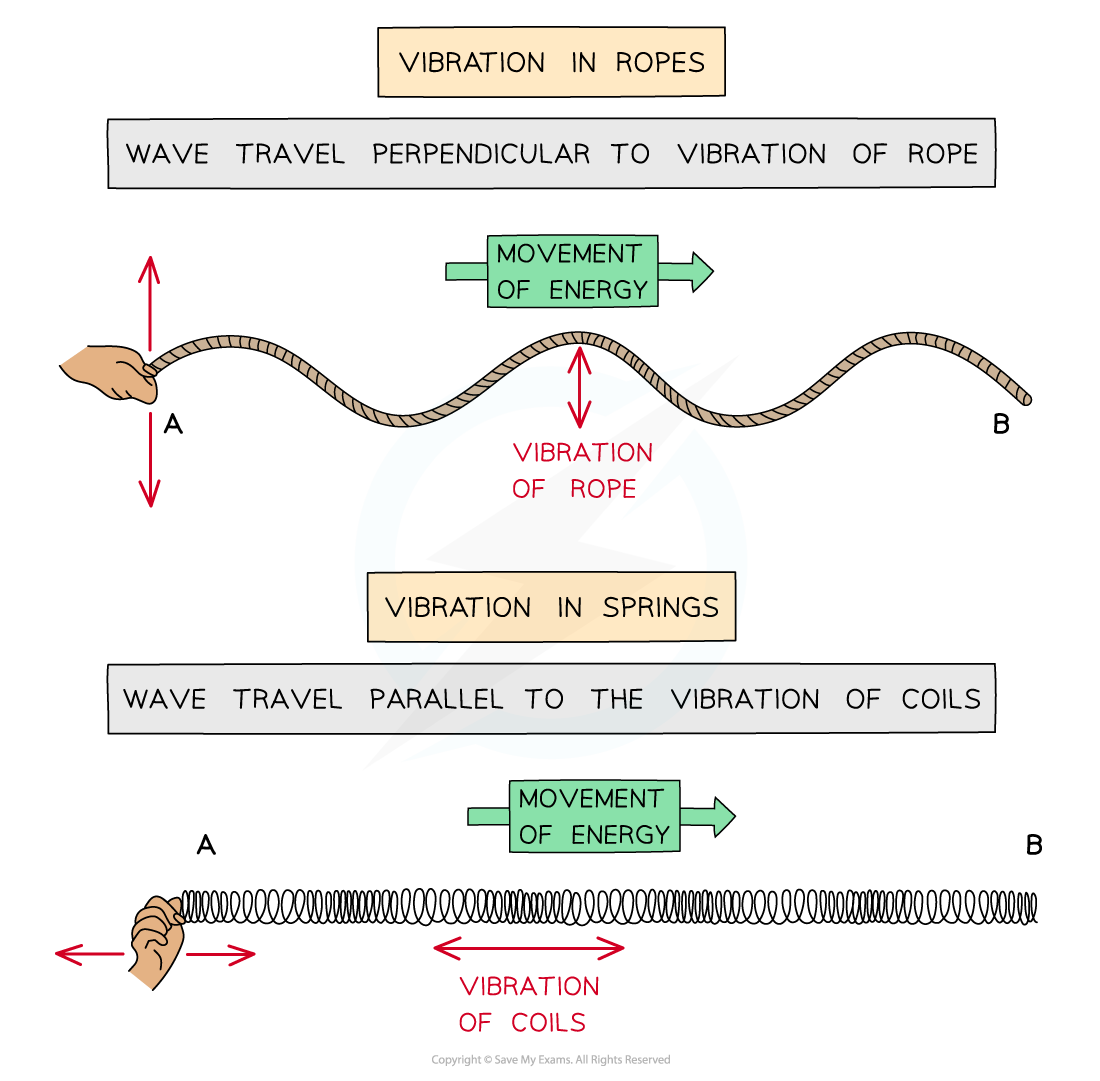Transverse & Longitudinal Waves (Edexcel GCSE Combined Science): Revision Note
Did this video help you?
Transverse & Longitudinal Waves
Waves are repeated vibrations that transfer energy
Energy is transferred by parts of the wave knocking nearby parts
This is similar to the effect of people knocking into one another in a crowd, or a "Mexican Wave" at football matches
Waves can exist as one of two types:
Transverse
Longitudinal
Transverse Waves
Transverse waves are defined as:
Waves where the points along its length vibrate at 90 degrees to the direction of energy transfer
For a transverse wave:
The energy transfer is perpendicular to wave motion
They transfer energy, but not the particles of the medium
They can move in solids and on the surfaces of liquids but not inside liquids or gases
Some transverse waves (electromagnetic waves) can move in solids, liquids and gases and in a vacuum
The point on the wave that is:
The highest above the rest position is called the peak, or crest
The lowest below the rest position is called the trough

Transverse waves can be seen in a rope when it is moved quickly up and down
Examples of transverse waves are:
Ripples on the surface of water
Vibrations in a guitar string
S-waves (a type of seismic wave)
Electromagnetic waves (such as radio, light, X-rays etc)
Representing Transverse Waves
Transverse waves are drawn as a single continuous line, usually with a central line showing the undisturbed position
The curves are drawn so that they are perpendicular to the direction of energy transfer
These represent the peaks and troughs

Transverse waves are represented as a continuous solid line
Longitudinal Waves
Longitudinal waves are defined as:
Waves where the points along its length vibrate parallel to the direction of energy transfer
For a longitudinal wave:
The energy transfer is in the same direction as the wave motion
They transfer energy, but not the particles of the medium
They can move in solids, liquids and gases
They can not move in a vacuum (since there are no particles)
The key features of a longitudinal wave are where the points are:
Close together, called compressions
Spaced apart, called rarefactions

Longitudinal waves can be seen in a slinky spring when it is moved quickly backwards and forwards
Examples of longitudinal waves are:
Sound waves
P-waves (a type of seismic wave)
Pressure waves caused by repeated movements in a liquid or gas
Representing Longitudinal Waves
Longitudinal waves are usually drawn as several lines to show that the wave is moving parallel to the direction of energy transfer
Drawing the lines closer together represents the compressions
Drawing the lines further apart represents the rarefactions

Longitudinal waves are represented as sets of lines with rarefactions and compressions
Comparing Transverse & Longitudinal Waves
Wave vibrations can be shown on ropes (transverse) and springs (longitudinal)

Waves can be shown through vibrations in ropes or springs
The different properties of transverse and longitudinal waves are shown in the table:
Transverse Waves v Longitudinal Waves Table
Property | Transverse waves | Longitudinal waves |
|---|---|---|
Structure | Peaks and troughs | Compressions and rarefactions |
Vibration | Right angles to the direction of energy transfer | Parallel to the direction of energy transfer |
Vacuum | Only electromagnetic waves can travel in a vacuum | Cannot travel in a vacuum |
Material | Can move in solids and the surfaces of liquids | Can move in solids, liquids and gases |
Density | A constant density | The density of the wave changes |
Pressure | Has a constant pressure | Pressure in the wave changes |
Speed of wave | Depends on the material the wave is travelling in | Depends on the material the wave is travelling in |
Worked Example
The diagram below shows the direction of a P-wave in a sample of rock during an earthquake.

Draw arrows on the diagram to show how the piece of rock, labelled R, moves as the P-wave passes through it.
Answer:
Step 1: Recall if a P-wave is transverse or longitudinal
P-waves are longitudinal waves
Step 2: Recall the definition of longitudinal waves
Points along longitudinal waves vibrate parallel to the direction of energy transfer
This means the rock vibrates in a line parallel to the direction of the P-wave drawn
Step 3: Draw arrows at the point labelled R to show it vibrating in parallel to the direction of the P-wave
This is shown in the image below

Examiner Tips and Tricks
Exam questions may ask you to describe waves and this is most easily done by drawing a diagram of the wave and then describing the parts of the wave - a good, clearly labelled diagram can earn you full marks! Make sure you know the difference between the wavefront diagram and the longitudinal wave diagram, do not confuse the two!

You've read 0 of your 5 free revision notes this week
Sign up now. It’s free!
Did this page help you?
